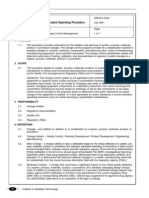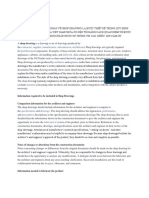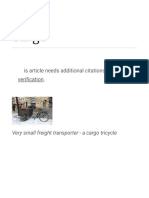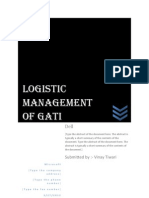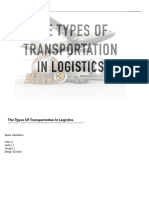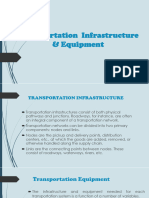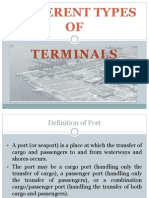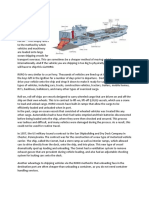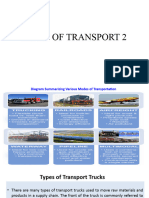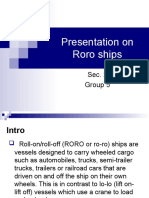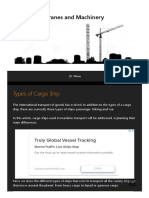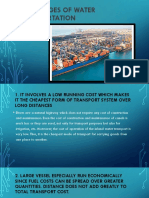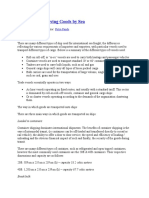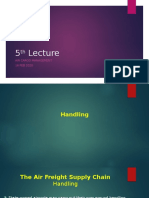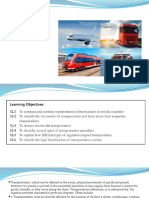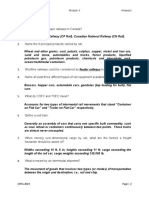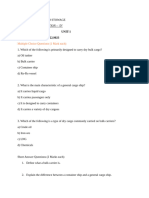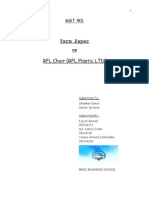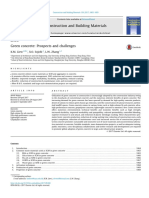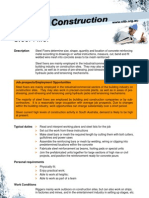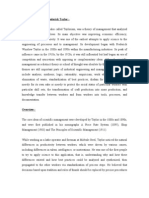Cargo - Wikipedia, The Free Encyclopedia
Cargo - Wikipedia, The Free Encyclopedia
Uploaded by
Pankaj SinghCopyright:
Available Formats
Cargo - Wikipedia, The Free Encyclopedia
Cargo - Wikipedia, The Free Encyclopedia
Uploaded by
Pankaj SinghCopyright
Available Formats
Share this document
Did you find this document useful?
Is this content inappropriate?
Copyright:
Available Formats
Cargo - Wikipedia, The Free Encyclopedia
Cargo - Wikipedia, The Free Encyclopedia
Uploaded by
Pankaj SinghCopyright:
Available Formats
12/6/12
Cargo - Wikipedia, the f ree ency clopedia
Cargo
From Wikipedia, the free encyclopedia
Cargo (or freight) is goods or produce transported, generally for commercial gain, by ship or aircraft, although the term is now extended to intermodal train, van or truck. In modern times, containers are used in most long-haul cargo transport.
Contents
1 Transportation types 1.1 Marine 1.2 Air 1.3 Train 1.4 Road 2 Shipment categories 2.1 Less-than-truckload freight 2.2 Air freight 2.3 Truckload freight 3 Shipping costs 4 Security concerns 5 Stabilization 6 See also 7 References 7.1 Reference bibliography 8 External links
Cargo being unloaded from a ship using a cargo net at Haikou New Port, Haikou City, Hainan, China
Transportation types
Marine
Seaport terminals handle a wide range of maritime cargo. Automobiles are handled at many ports and are usually carried on specialized roll-on/roll-off ships. Break bulk cargo is typically material stacked on pallets and lifted into and out of the hold of a vessel by cranes on the dock or aboard the ship itself. The volume of break bulk cargo has declined dramatically worldwide as containerization has grown. One way to secure break bulk and freight in intermodal containers is by using Dunnage Bags. Container ship at Helsinki Port, Bulk cargo, such as salt, oil, tallow, and scrap metal, is usually Finland defined as commodities that are neither on pallets nor in containers. Bulk cargoes are not handled as individual pieces, the way heavy-lift and project cargoes are. Alumina, grain, gypsum, logs and wood chips, for instance,
en.wikipedia.org/wiki/Cargo 1/6
12/6/12
Cargo - Wikipedia, the f ree ency clopedia
are bulk cargoes. Neo-bulk cargo comprises individual units that are counted as they are loaded and unloaded, in contrast to bulk cargo that is not counted, but that are not containerized.[1] Containers are the largest and fastest growing cargo category at most ports worldwide. Containerized cargo includes everything from auto parts, machinery and manufacturing components to shoes and toys to frozen meat and seafood. Project cargo and the heavy lift cargo include items like manufacturing equipment, air conditioners, factory components, generators, wind turbines, military equipment, and almost any other oversized or overweight cargo which is too big or too heavy to fit into a container.
Air
Main article: Air Cargo Air cargo, commonly known as air freight, is collected by firms from shippers and delivered to customers. Aircraft were first used for carrying mail as cargo in 1911. Eventually manufacturers started designing aircraft for other types of freight as well. There are many commercial aircraft suitable for carrying cargo such as the Boeing 747 and the bigger An-124, which was purposely built for easy conversion into a cargo aircraft. Such large aircraft employ quick-loading containers known as Unit Load Devices (ULDs), much like containerized cargo ships. The ULDs are located in front section of the aircraft.
Cargolux Boeing 747-400F with the nose loading door open
Most nations own and utilize large numbers of cargo aircraft such as the C-17 Globemaster III for airlift logistic needs.
Train
Main article: Freight train Trains are capable of transporting large numbers of containers that come from shipping ports. Trains are also used for the transportation of steel, wood and coal. They are used because they can carry a large amount and generally have a direct route to the destination. Under the right circumstances, freight transport by rail is more economic and energy efficient than by road, especially when carried in bulk or over long distances. The main disadvantage of rail freight is its lack of flexibility. For this reason, rail has lost much of the freight business to road transport. Rail freight is often subject to transshipment costs, since it must be transferred from one mode of transportation to another. Practices such as containerization aim at minimizing these costs.
A picture of a P&O Nedlloyd inter-modal freight well car at Banbury station in the year 2001
Many governments are currently trying to encourage shippers to use trains more often because of the environmental benefits.[2]
Road
en.wikipedia.org/wiki/Cargo 2/6
12/6/12
Cargo - Wikipedia, the f ree ency clopedia
Main article: Truck Many firms, like Parcelforce, FedEx and R+L Carriers transport all types of cargo by road. Delivering everything from letters to houses to cargo containers, these firms offer fast, sometimes same-day, delivery. A good example of road cargo is food, as supermarkets require deliveries every day to keep their shelves stocked with goods. Retailers of all kinds rely upon delivery trucks, be they full size semi trucks or smaller delivery vans.
Shipment categories
Freight is usually organized into various shipment categories before it is transported. An item's category is determined by: the type of item being carried. For example, a kettle could fit into the category 'household goods'. how large the shipment is, in terms of both item size and quantity. how long the item for delivery will be in transit. Shipments are typically categorized as household goods, express, parcel, and freight shipments: Household goods (HHG) include furniture, art and similar items. Very small business or personal items like envelopes are considered overnight express or express letter shipments. These shipments are rarely over a few kilograms or pounds and almost always travel in the carriers own packaging. Express shipments almost always travel some distance by air. An envelope may go coast to coast in the United States overnight or it may take several days, depending on the service options and prices chosen by the shipper. Larger items like small boxes are considered parcels or ground shipments. These shipments are rarely over 50 kg (110 lb), with no single piece of the shipment weighing more than about 70 kg (154 lb). Parcel shipments are always boxed, sometimes in the shippers packaging and sometimes in carrierprovided packaging. Service levels are again variable but most ground shipments will move about 800 to 1,100 kilometres (497 to 684 mi) per day. Depending on the origin of the package, it can travel from coast to coast in the United States in about four days. Parcel shipments rarely travel by air and typically move via road and rail. Parcels represent the majority of business-to-consumer (B2C) shipments. Beyond HHG, express, and parcel shipments, movements are termed freight shipments.
Less-than-truckload freight
Main article: Less than truckload shipping Less than truckload (LTL) cargo is the first category of freight shipment, which represents the majority of freight shipments and the majority of business-to-business (B2B) shipments. LTL shipments are also often referred to as motor freight and the carriers involved are referred to as motor carriers. LTL shipments range from 50 to 7,000 kg (110 to 15,000 lb), being less than 2.5 to 8.5 m (8 ft 2.4 in to 27 ft 10.6 in) the majority of times. The average single piece of LTL freight is 600 kg (1,323 lb) and the size of a standard pallet. Long freight and/or large freight are subject to extreme length and cubic capacity surcharges. Trailers used in LTL can range from 28 to 53 ft (8.53 to 16.15 m). The standard for city deliveries is usually
en.wikipedia.org/wiki/Cargo
48 ft (14.63 m). In tight and residential environments the 28 ft (8.53 m) trailer is used the most.
3/6
12/6/12
Cargo - Wikipedia, the f ree ency clopedia
48 ft (14.63 m). In tight and residential environments the 28 ft (8.53 m) trailer is used the most. The shipments are usually palletized, stretch [shrink]-wrapped and packaged for a mixed-freight environment. Unlike express or parcel, LTL shippers must provide their own packaging, as carriers do not provide any packaging supplies or assistance. However, circumstances may require crating or other substantial packaging.
Air freight
Air freight shipments are very similar to LTL shipments in terms of size and packaging requirements. However, air freight or air cargo shipments typically need to move at much faster speeds than 800 km or 497 mi per day. Air shipments may be booked directly with the carriers, through brokers or with online marketplace services. While shipments move faster than standard LTL, air shipments dont always actually move by air.
Truckload freight
In the United States, shipments larger than about 7,000 kg (15,432 lb) are typically classified as truckload (TL) freight. This is because it is more efficient and economical for a large shipment to have exclusive use of one larger trailer rather than share space on a smaller LTL trailer. The total weight of a loaded truck (tractor and trailer, 5-axle rig) cannot exceed 36,000 kg (79,366 lb) in the United States{fact}. In ordinary circumstances, long-haul equipment will weigh about 15,000 kg (33,069 lb), leaving about 20,000 kg (44,092 lb) of freight capacity. Similarly a load is limited to the space available in the trailer, normally 48 ft (14.63 m) or 53 ft (16.15 m) long, 2.6 m (102.4 in) wide, 2.7 m (8 ft 10.3 in) high and 13 ft 6 in/4.11 m high over all. While express, parcel and LTL shipments are always intermingled with other shipments on a single piece of equipment and are typically reloaded across multiple pieces of equipment during their transport, TL shipments usually travel as the only shipment on a trailer. In fact, TL shipments usually deliver on exactly the same trailer as they are picked up on.
Shipping costs
Often, an LTL shipper may realize savings by utilizing a freight broker, online marketplace or other intermediary, instead of contracting directly with a trucking company. Brokers can shop the marketplace and obtain lower rates than most smaller shippers can obtain directly. In the LTL marketplace, intermediaries typically receive 50% to 80% discounts from published rates, where a small shipper may only be offered a 5% to 30% discount by the carrier. Intermediaries are licensed by the DOT and have requirements to provide proof of insurance. Truckload (TL) carriers usually charge a rate per kilometre or mile. The rate varies depending on the distance, geographic location of the delivery, items being shipped, equipment type required, and service times required. TL shipments usually receive a variety of surcharges very similar to those described for LTL shipments above. In the TL market, there are thousands more small carriers than in the LTL market. Therefore, the use of transportation intermediaries or brokers is extremely common. Another cost-saving method is facilitating pickups or deliveries at the carriers terminals. By doing this, shippers avoid any accessorial fees that might normally be charged for liftgate, residential pickup/delivery, inside pickup/delivery, or notifications/appointments. Carriers or intermediaries can provide shippers with the address and phone number for the closest shipping terminal to the origin and/or destination. Shipping experts optimize their service and costs by sampling rates from several carriers, brokers and online marketplaces. When obtaining rates from different providers, shippers may find quite a wide range in the pricing
en.wikipedia.org/wiki/Cargo 4/6
12/6/12
offered. If a shipper uses a broker, freight forwarder or other transportation intermediary, it is common for the shipper to receive a copy of the carrier's Federal Operating Authority. Freight brokers and intermediaries are also required by Federal Law to be licensed by the Federal Highway Administration. Experienced shippers avoid unlicensed brokers and forwarders because if brokers are working outside the law by not having a Federal Operating License, the shipper has no protection in the event of a problem. Also, shippers normally ask for a copy of the broker's insurance certificate and any specific insurance that applies to the shipment.
Security concerns
Governments are very concerned with the shipment of cargo, as it may bring security risks to a country. Therefore, many governments have enacted rules and regulations, administered by a customs agency, to the handling of cargo to minimize risks of terrorism and other crime. Of particular concern is cargo entering through a country's borders. The United States has been one of the leaders in securing cargo. They see cargo as a concern to national security. After the terrorist attacks of September 11th, the security of this magnitude of cargo has become highlighted on the over 6 million cargo containers enter the United States ports each year.[3] The latest US Government response to this threat is the CSI: Container Security Initiative. CSI is a program intended to help increase security for containerized cargo shipped to the United States from around the world.[4] Europe is also focusing on this issue, with a number of EU-funded projects underway.[5]
Stabilization
There are many different ways and materials available to stabilize and secure cargo in the various modes of transportation. Conventional load securing methods and materials such as steel strapping and plastic/wood blocking & bracing have been used for decades and are still widely used. Present load securing methods offer several other options including polyester strapping and lashing, synthetic webbings and dunnage bags, also known as air bags or inflatable bags.
Application in container
Polyester Strapping and Dunnage Bag application
Polyester Lashing Application
See also
Cargo airline Cargo sampling
en.wikipedia.org/wiki/Cargo
Counter-to-counter package
Goods train IATA e-freight
5/6
12/6/12
Cargo - Wikipedia, the f ree ency clopedia
Cargo scanning Momentum Transport
Dial-a-truck (DAT) Freight company Freight Transport Association Goods
OwnerOperator Independent Drivers Association Products Standard Carrier Alpha Codes Document automation in supply chain management & logistics
References
1. ^ CambridgeSystematics 1998, pp. 79. 2. ^ http://www.mjc2.com/e-freight-logistics.htm EU-sponsored promotion of rail and barge 3. ^ Murray Unveils First-in-the-Nation Port Security Demonstration (http://murray.senate.gov/news.cfm? id=191247) 4. ^ CSI: Container Security Initiative (http://www.cbp.gov/xp/cgov/border_security/international_activities/csi/) 5. ^ http://www.mjc2.com/container-logistics-security-optimization.htm CONTAIN - container security optimization
Reference bibliography
* Cambridge Systematics (1998). Multimodal corridor and capacity analysis manual. Transportation Research Board. ISBN 978-0-309-06072-1.
External links
The Gallery of Transport Loss -- Photos & Lessons of Disaster (http://cargolaw.com/gallery.html) Retrieved from "http://en.wikipedia.org/w/index.php?title=Cargo&oldid=525567999" Categories: Commercial item transport and distribution Shipping Transport This page was last modified on 29 November 2012 at 18:07. Text is available under the Creative Commons Attribution-ShareAlike License; additional terms may apply. See Terms of Use for details. Wikipedia is a registered trademark of the Wikimedia Foundation, Inc., a non-profit organization.
en.wikipedia.org/wiki/Cargo
6/6
You might also like
- Change Control Management SOPDocument7 pagesChange Control Management SOPcarbou100% (8)
- UNIT 2 - COMMERCIAL SHIPPING For StudentsDocument23 pagesUNIT 2 - COMMERCIAL SHIPPING For StudentsDajae Nelson100% (2)
- Chapter 6 Quiz and AssignmentDocument25 pagesChapter 6 Quiz and AssignmentSaeym SegoviaNo ratings yet
- Cost Accumulation For Job-Shop & Batch Production OperationsDocument60 pagesCost Accumulation For Job-Shop & Batch Production Operationstrillion5No ratings yet
- Shop Drawing: Contractor Supplier Manufacturer Subcontractor Fabricator Prefabricated Millwork MEP Architects EngineersDocument4 pagesShop Drawing: Contractor Supplier Manufacturer Subcontractor Fabricator Prefabricated Millwork MEP Architects EngineersKien NguyenNo ratings yet
- LPG Panjang Project Information LPG Presentation Share1Document35 pagesLPG Panjang Project Information LPG Presentation Share1swatched100% (1)
- Cargo: This Article Needs Additional Citations For VerificationDocument39 pagesCargo: This Article Needs Additional Citations For VerificationLourembam SinghaNo ratings yet
- Logistic Management of Gati: Submitted By:-Vinay TiwariDocument24 pagesLogistic Management of Gati: Submitted By:-Vinay Tiwarivtiwari2No ratings yet
- ESP Logistics Manual - Unit 3Document17 pagesESP Logistics Manual - Unit 3Jorge MonsalveNo ratings yet
- Ocean FreightDocument7 pagesOcean Freightsajida HajjuNo ratings yet
- Cargo and Packaging 1Document31 pagesCargo and Packaging 1Nureni SusilowatiNo ratings yet
- 8 Major Types of Cargo Transported Through The Shipping IndustryDocument10 pages8 Major Types of Cargo Transported Through The Shipping IndustryGiorgi KandelakiNo ratings yet
- Shipping ManagementDocument58 pagesShipping Managementjeyanofficial12No ratings yet
- Container OperationsDocument15 pagesContainer OperationsKiriakos Ifantidis100% (1)
- Topic 1 Modes of TransportationDocument8 pagesTopic 1 Modes of TransportationAbigail SalasNo ratings yet
- SEAM3 Learning Module 3Document27 pagesSEAM3 Learning Module 3Frednixen Bustamante Gapoy100% (1)
- Bulk Cargo: ShipbrokersDocument4 pagesBulk Cargo: ShipbrokersVaishali ShuklaNo ratings yet
- Types of Ship and Port Material Handling Equipment & TechnologyDocument36 pagesTypes of Ship and Port Material Handling Equipment & TechnologyKaren Shui100% (20)
- Liner Shipping: Introduction To Transportation and NavigationDocument17 pagesLiner Shipping: Introduction To Transportation and NavigationSha Eem100% (2)
- Logistica y Proceso MultimodalesDocument16 pagesLogistica y Proceso MultimodalesDIEGO GARCÍANo ratings yet
- Lesson 2 SHIP TYPESDocument11 pagesLesson 2 SHIP TYPESNelton Xadreque NhachungueNo ratings yet
- 2.CARGO WORK For TDocument3 pages2.CARGO WORK For TjoelNo ratings yet
- Maritime EnglishDocument7 pagesMaritime EnglishselomnNo ratings yet
- Chapter 03Document45 pagesChapter 03linhquyt00No ratings yet
- Training Manual (Final Version) (1)Document54 pagesTraining Manual (Final Version) (1)kevinNo ratings yet
- Different Types of Terminals TasarimDocument55 pagesDifferent Types of Terminals TasarimOltan Uzun100% (1)
- PDF Copy of Lecture 2 - Sea Freight LogisticsDocument23 pagesPDF Copy of Lecture 2 - Sea Freight LogisticsKomal Dwivedi100% (2)
- RoroDocument12 pagesRoroPearl NixenNo ratings yet
- Cosco Shippling LTD ReportDocument48 pagesCosco Shippling LTD ReportShabaaz Hassan100% (1)
- Mode of Transport 2 - StuDocument75 pagesMode of Transport 2 - StuDaniel Ahiaba JuniorNo ratings yet
- Textbook Cargo OperationsDocument42 pagesTextbook Cargo Operationskarpekin.vladNo ratings yet
- General Structure of ShippingDocument62 pagesGeneral Structure of ShippingRamalingam ChandrasekharanNo ratings yet
- Bulk Cargoes and Economics of ShippingDocument17 pagesBulk Cargoes and Economics of ShippingBlack StormNo ratings yet
- EJ1S8 Cargo, Powerpoint PresentationsDocument2 pagesEJ1S8 Cargo, Powerpoint Presentationsmihaela.jakovac9824No ratings yet
- Vessel Types ExplainedDocument6 pagesVessel Types Explainedrifqi mubarokNo ratings yet
- SHIPB6001A - 2023 - T3 - Reading For Midterm QuizDocument9 pagesSHIPB6001A - 2023 - T3 - Reading For Midterm Quizshennny3No ratings yet
- New Microsoft Power Point PresentationDocument21 pagesNew Microsoft Power Point PresentationDrAbdoz EngineeroNo ratings yet
- Freight Forwarding Chapter 3Document63 pagesFreight Forwarding Chapter 3Ajeet Krishnamurthy100% (2)
- Cargo LinersDocument5 pagesCargo Linersa.gueyeNo ratings yet
- Ship Management IDocument23 pagesShip Management Ipisourie25100% (2)
- Types of Cargo ShipDocument20 pagesTypes of Cargo ShipNIKE IKA NUZULANo ratings yet
- Cochin Port Trust Latest OSDocument96 pagesCochin Port Trust Latest OSRahul R Naik0% (1)
- Ocean Transport IncludesDocument1 pageOcean Transport Includesshafiqah shahNo ratings yet
- Advantages of Water TransportDocument22 pagesAdvantages of Water TransportCouncil of Tourism StudentsNo ratings yet
- UNIT III ShippingDocument44 pagesUNIT III ShippingNantenin MagassoubaNo ratings yet
- Securing The Product in The ContainerDocument1,033 pagesSecuring The Product in The ContainerLupu AlexandruNo ratings yet
- 0-VNS - ISO Tank TransportDocument56 pages0-VNS - ISO Tank Transportvns081104No ratings yet
- What Is Ocean Freight?Document11 pagesWhat Is Ocean Freight?Parth ShashooNo ratings yet
- Logistical Network AnalysisDocument21 pagesLogistical Network Analysissiddhesh kadamNo ratings yet
- A Guide To Moving Goods by SeaDocument22 pagesA Guide To Moving Goods by SeaSabir S. GhaffarNo ratings yet
- Ship S Dimension & Types of ShipsDocument13 pagesShip S Dimension & Types of ShipsAdrianUrbinaNo ratings yet
- 5th Lecture Air CargoDocument20 pages5th Lecture Air CargoHassan KhanNo ratings yet
- Maritime TransportationDocument37 pagesMaritime Transportationbehzad parsiNo ratings yet
- Container Shipping Course ModuleDocument49 pagesContainer Shipping Course Moduleliao_marcoNo ratings yet
- Chapter 8Document27 pagesChapter 8Cẩm MiiNo ratings yet
- Exercise 3.1: INTL 704 AnswersDocument3 pagesExercise 3.1: INTL 704 AnswersEcren KELEŞNo ratings yet
- Bulk Shipment by Ship Planning & Routing Division October 31/2019Document23 pagesBulk Shipment by Ship Planning & Routing Division October 31/2019TeshaleNo ratings yet
- Lesson Five Sea Freight and TarrifsDocument10 pagesLesson Five Sea Freight and Tarrifslucyelizabeth606No ratings yet
- Cargo OperationDocument85 pagesCargo OperationMahami M Prosper100% (1)
- Cargo Handling Question PaperDocument6 pagesCargo Handling Question Papersatyamorton23No ratings yet
- What Are Cargo Ships?: Facebook Twitter Google+ Linkedin PinterestDocument7 pagesWhat Are Cargo Ships?: Facebook Twitter Google+ Linkedin PinterestDaniel CastilloNo ratings yet
- Chapter 15Document8 pagesChapter 15AsipheNo ratings yet
- Topic 1 - Perspective in The Industry by Aris Renz SangalangDocument28 pagesTopic 1 - Perspective in The Industry by Aris Renz Sangalangaris renz sangalangNo ratings yet
- Types of VesselsDocument16 pagesTypes of VesselsMarina TsynovaNo ratings yet
- Marine Logistics including Liquid Cargo and Bulk CargoFrom EverandMarine Logistics including Liquid Cargo and Bulk CargoRating: 3 out of 5 stars3/5 (1)
- MGT 401 Final ReportDocument16 pagesMGT 401 Final ReportkemimahamudNo ratings yet
- Prodcut Defectsin ExtrusionDocument19 pagesProdcut Defectsin ExtrusiontechopelessNo ratings yet
- Kerala-Data Base Electronics IndustryDocument36 pagesKerala-Data Base Electronics IndustrymayankmhNo ratings yet
- ErbosanCatalogue PDFDocument20 pagesErbosanCatalogue PDFAna Silva PintoNo ratings yet
- General Catalogue Section C Engineering Class ChainDocument220 pagesGeneral Catalogue Section C Engineering Class Chainmkpasha55mpNo ratings yet
- 02515Document5 pages02515uddinnadeemNo ratings yet
- In Partial Fulfillment For The Award of The Degree ofDocument11 pagesIn Partial Fulfillment For The Award of The Degree ofKumar DneshNo ratings yet
- Manaav SadhnaDocument13 pagesManaav SadhnaRashida RangwalaNo ratings yet
- P'R 1 Dp"Jt-I : Republic of The PhilippinesDocument5 pagesP'R 1 Dp"Jt-I : Republic of The PhilippinesjrsiaseNo ratings yet
- DHL Case Study - Refrigerated Warehousing - Consumer - Mexico enDocument2 pagesDHL Case Study - Refrigerated Warehousing - Consumer - Mexico enMa Antonieta Naneth LopezNo ratings yet
- Science Notes Year 6Document6 pagesScience Notes Year 6esther1phan100% (2)
- Green ConcrteteDocument33 pagesGreen ConcrteteIonutNo ratings yet
- Estimation & CostingDocument31 pagesEstimation & CostingKrztofer PrnzNo ratings yet
- ABS-M30 - Material Spec Sheet - Web - English - 08-2015Document2 pagesABS-M30 - Material Spec Sheet - Web - English - 08-2015David EwingNo ratings yet
- Roller Hearth Furnaces For Heat Treatment in Hot FDocument23 pagesRoller Hearth Furnaces For Heat Treatment in Hot FRaghu BhatNo ratings yet
- Supply & Demand 10Document8 pagesSupply & Demand 10zakria100100No ratings yet
- Water Reducing AdmixtureDocument2 pagesWater Reducing AdmixtureBryanMatthewLontokNo ratings yet
- Mee2007 Cad CamDocument2 pagesMee2007 Cad CamSrivathson EswaranNo ratings yet
- Courses of Study and Scheme of Assessment Me Engineering DesignDocument2 pagesCourses of Study and Scheme of Assessment Me Engineering DesignPriyadarshini KrishnaswamyNo ratings yet
- Construction Careers - Steel FixerDocument2 pagesConstruction Careers - Steel Fixeryrdgcgf5664No ratings yet
- G 105 PDFDocument88 pagesG 105 PDFsmithwork100% (1)
- Polyken 936 TapeDocument2 pagesPolyken 936 TapeKyaw Kyaw AungNo ratings yet
- Digboi MilestonesDocument3 pagesDigboi MilestonesIqubal HussainNo ratings yet
- What Does Regenerative Air Pre-Heater Means, Why They Named SoDocument10 pagesWhat Does Regenerative Air Pre-Heater Means, Why They Named SoAbdulyunus AmirNo ratings yet
- Scientific Theory of Frederick TaylorDocument15 pagesScientific Theory of Frederick TaylorCh FarrukhNo ratings yet
